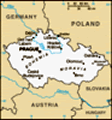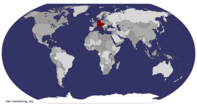Advertisement
Published: August 20th 2019
I have had a wonderful and relaxing few days with Reni and Gerhard at their holiday home but today it is time to continue my European adventure. Reni and Gerhard see me off at Gmünd station which is just on the Austrian side of the Austrian/Czech border. If you look at the atlas you will see just how many countries do border Austria! I used to become quite tearful when saying Goodbye, but these days we tend to see each other at least four times a year, so it isn’t too bad. In fact, I shall be heading back to Vienna in three weeks time to celebrate Reni’s 60th. I cannot believe that she is that age!! I enjoy a pleasant train journey through the Czech Republic. The first train, a local stopper, is quite full. I change at a station called Veselí nad Lužnicí for the train to Prague. This second train is more of an express and I have a compartment to myself most of the way. This western side of the Czech Republic where I am heading was known formerly as Bohemia and the eastern side was known as Moravia.
The train arrives punctually in
Prague’s vast main station. With its 1.3 million inhabitants this city feels huge in comparison with the last few places I have visited. I will have less than 24 hours in Prague and I need to make the most of my time. I arrive at my hotel after a ten-minute stroll just before 1pm. The small hotel (only 12 bedrooms) is totally charming and in a fantastic, central location - half way between Wenceslas Square and the lovely Staromestske namesti (Old Town Square). My room is vast and sumptuous. It has high ceilings, wonderful sash windows, a parquet floor, huge comfy bed and a fabulous and large bathroom. My room was just ready as I arrive so I am able to drop my bag and freshen up before meeting Sue’s friend, Marcela at 1.30. She is now retired but had worked as a guide in Prague for well over 30 years and has worked with Sue’s groups for a long time. I have never met Marcela but know that she is over 80 years old. I honestly expected that we would meet up for a coffee and a chat about how she would normally run one of our city tours.
I could not have been more wrong. Firstly, she doesn’t look a day over 65. She is incredibly fit and healthy looking. Secondly, she has prepared a full tour for me. I am overwhelmed at how generous she is with her time and knowledge and we spend a fabulous afternoon together. She shows me so much and explains even more - I couldn’t possibly write it all here, although I will try to mention the highlights and show some photos. I know many of my friends have already visited Prague. For anyone who hasn’t, this must be the gold-plated version of a city tour - spending half a day with someone as knowledgeable as Marcela.
We first take a tram up to the Castle area - Hradčany. Once through the security gate there is so much to see and do up here (and you can see and do lots without having to pay entrance fees). Prague Castle is both the metaphorical and the historical throne of the Czech lands. Around AD 880 a wooden fortress was built on this hilltop above the river. In the 14th century the castle became the seat of the
Holy Roman Empire. Much of it was rebuilt by Empress Maria Theresa in the second half of the 18th century, giving it a formal Neo-Classical look. Nowadays the castle is the official residence of the Czech president. Ideally you would spend much longer up here - I would recommend at least half a day - more if you want to see the exhibitions in the art galleries. Some of the highlights include the spectacular St Vitus Cathedral and its Great South Tower and Treasury, St George’s Basilica, Old Royal Palace, the Picture Gallery, the Story of Prague Castle, Rosenberg Palace and Golden Lane (goldsmiths lived in the colourful houses that were built into the castle walls in order to avoid paying guild dues). And then there are the beautiful gardens - Royal Garden, Garden on the Bastion, Horticultural Gardens, Terrace of the Riding School, St Wenceslas Vineyard - to name just a few. After spending a couple of fascinating hours in the Castle area we stroll back down through the vineyard. What a lovely path with fabulous panoramic views of the city of Prague at every turn!
After wiggling through some lovely old streets and strolling through
some glorious gardens at the foot of the Castle area we cross over Charles Bridge. We stop often as there are so many landmarks and features that Marcela points out and wants to explain, and I also want to take lots of photos. Charles Bridge (Karluv most in Czech) is just one of 17 bridges across the River Vltava within the city of Prague, and it is the best known one. It links Lesser Town where we just were to Old Town where we are now headed. The bridge is named after Charles IV who had it built in 1357, and it has seen a fair number of processions, battles, executions and film shoots. It is built in Gothic style to replace its predecessor, the Judith Bridge. It is half a kilometre long and supported by 16 massive piers, with both ends fortified by towers. Until the 19th century it was the only bridge in Prague. One of the bridge’s main features is the gallery of 30 statues. Nowadays these are all copies with the originals preserved in museums across the city. Midway across the bridge is a brass cross where John of Nepomuk’s body was thrown into the river.
Wishes made at this cross are supposed to come true. At the base of the statue of St John there is a brass relief showing a man diving into the river. Rubbing this to attract good luck is another old tradition.
We are in Old Town now and every street looks wonderful. We are heading to Old Town Square - the heart and soul of the city. There was a market place here in the 11th century, but it was in 1338 when John of Luxembourg gave Prague’s citizens permission to form a Town Council, that the Old Town Hall was built and the square came into its own. Nowadays it has a really lively atmosphere with café tables set out in front of painted façades and horse-drawn carriages waiting to ferry tourists around. We see signs everywhere for trdelníky (chimney cakes). Marcela is not impressed at all and says it is a myth that these are traditional Czech fare. Feeling slightly disappointed I decide against testing them for ‘research purposes’.
Some of the main features of the Old Town Square include St Nicholas Cathedral, Church of our Lady before Tyn, House at the
Stone Bell, the Štorch House, Marian Column, KInsky Palace. One of the most popular attractions in Prague is the Astronomical Clock in the Old Town Hall. During daylight hours (in the summer from 9am to 9pm) bells ring, cocks crow and 15th-century statues dance on the hour while crowds of tourists gather to watch from below. Twelve wooden apostles emerge from the clock every hour. These were carved by a contemporary artist to replace the ones destroyed by German artillery in 1945. I am very moved by the Jan Hus Memorial - another of the key features of Old Town Square. Hus was burned at the stake (in Germany) in 1415 for proposing radical church reform. The inscription below the figure of Hus at the 1915 memorial reads “Truth Will Prevail”.
There are so many more places and names that Marcela has pointed out but we decide that it is time to call it a day, sit down and sample some local wine. Marcela knows a ‘locals’ place in a quiet courtyard close to the centre but far away from the hordes. We sit outside and chatter contentedly whilst enjoying a lovely Czech Riesling. In Czech this
wine is called Ryzling Rynsky. Marcela is wonderful company and I feel extremely fortunate to have had such an amazing private tour of the city. She promises that next time I am in Prague that we will visit the Jewish Quarter together as we just couldn’t fit it in today.
I would love to return to Prague and spend at least two or three days here. If I had three days, I would have a full day for the Castle area, Cathedral and gardens, strolling there and back from the city centre. I would also like to spend half a day exploring the Jewish Quarter and a further half day walking and cruising along the river. And it would be wonderful to have some time to simply wander the city centre and explore off the beaten track as well as seeing some museums/galleries. I would recommend my hotel for anyone travelling independently. It is inexpensive (in comparison with the chains), superbly located and fantastic.
After an enjoyable, relaxed dinner (I get a recommendation from the hotel owner for a place nearby that is not too touristy), I walk up to Wenceslas Square. This former
horse market began to be redeveloped in the 19th century and rapidly became the commercial hub of Prague. It was renamed Wenceslas Square in 1848 in honour of Bohemia’s patron saint. Many of the buildings seen today date from the early 20th century with their attractive Art Nouveau façades. The square has been the venue for many historic events, most recently in 1989 when large, jubilant crowds gathered here to celebrate the end of Communism.
I return to my comfortable Hotel Jungman to reflect on yet another memorable day in another wonderful city.
Advertisement
Tot: 0.069s; Tpl: 0.013s; cc: 9; qc: 48; dbt: 0.0416s; 1; m:domysql w:travelblog (10.17.0.13); sld: 1;
; mem: 1.2mb
















Fiona
non-member comment
Wonderful city
You’ve reminded me how wonderful Prague is and made me want to visit again with your vivid descriptions. The hotel sounds great and what an amazing woman as a guide. I remember enjoying it when I went with the boys about 14 years ago - we travelled by train from Krakow. Time for another trip I think...